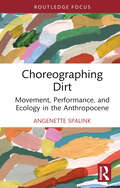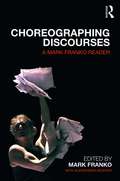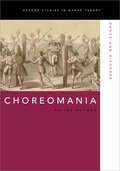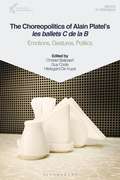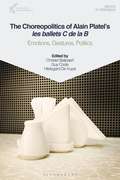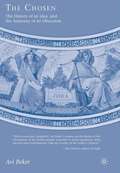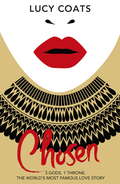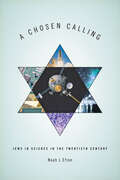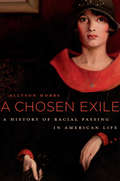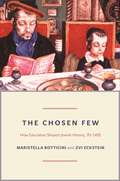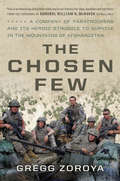- Table View
- List View
Choreographing Dirt: Movement, Performance, and Ecology in the Anthropocene (Routledge Studies in Theatre, Ecology, and Performance)
by Angenette SpalinkThis book is an innovative study that places performance and dance studies in conversation with ecology by exploring the significance of dirt in performance. Focusing on a range of 20th- and 21st-century performances that include modern dance, dance-theatre, Butoh, and everyday life, this book demonstrates how the choreography of dirt makes biological, geographical, and cultural meaning, what the author terms "biogeocultography". Whether it’s the Foundling Father digging into the earth’s strata in Suzan-Lori Park’s The America Play (1994), peat hurling through the air in Pina Bausch’s The Rite of Spring (1975), dancers frantically shovelling out fistfuls of dirt in Eveoke Dance Theatre’s Las Mariposas (2010), or Butoh performers dancing with fungi in Iván-Daniel Espinosa’s Messengers Divinos (2018), each example shows how the incorporation of dirt can reveal micro-level interactions between species – like the interplay between microscopic skin bacteria and soil protozoa – and macro-level interactions – like the transformation of peat to a greenhouse gas. By demonstrating the stakes of moving dirt, this book posits that performance can operate as a space to grapple with the multifaceted ecological dilemmas of the Anthropocene. This book will be of broad interest to both practitioners and researchers in theatre, performance studies, dance, ecocriticism, and the environmental humanities.
Choreographing Discourses: A Mark Franko Reader
by Mark FrankoChoreographing Discourses brings together essays originally published by Mark Franko between 1996 and the contemporary moment. Assembling these essays from international, sometimes untranslated sources and curating their relationship to a rapidly changing field, this Reader offers an important resource in the dynamic scholarly fields of Dance and Performance Studies. What makes this volume especially appropriate for undergraduate and graduate teaching is its critical focus on twentieth- and twenty-first-century dance artists and choreographers – among these, Oskar Schlemmer, Merce Cunningham, Kazuo Ohno, William Forsythe, Bill T. Jones, and Pina Bausch, some of the most high-profile European, American, and Japanese artists of the past century. The volume’s constellation of topics delves into controversies that are essential turning points in the field (notably, Still/Here and Paris is Burning), which illuminate the spine of the field while interlinking dance scholarship with performance theory, film, visual, and public art. The volume contains the first critical assessments of Franko’s contribution to the field by André Lepecki and Gay Morris, and an interview incorporating a biographical dimension to the development of Franko’s work and its relation to his dance and choreography. Ultimately, this Reader encourages a wide scope of conversation and engagement, opening up core questions in ethics, embodiment, and performativity.
Choreographing Discourses: A Mark Franko Reader
by Mark FrankoChoreographing Discourses brings together essays originally published by Mark Franko between 1996 and the contemporary moment. Assembling these essays from international, sometimes untranslated sources and curating their relationship to a rapidly changing field, this Reader offers an important resource in the dynamic scholarly fields of Dance and Performance Studies. What makes this volume especially appropriate for undergraduate and graduate teaching is its critical focus on twentieth- and twenty-first-century dance artists and choreographers – among these, Oskar Schlemmer, Merce Cunningham, Kazuo Ohno, William Forsythe, Bill T. Jones, and Pina Bausch, some of the most high-profile European, American, and Japanese artists of the past century. The volume’s constellation of topics delves into controversies that are essential turning points in the field (notably, Still/Here and Paris is Burning), which illuminate the spine of the field while interlinking dance scholarship with performance theory, film, visual, and public art. The volume contains the first critical assessments of Franko’s contribution to the field by André Lepecki and Gay Morris, and an interview incorporating a biographical dimension to the development of Franko’s work and its relation to his dance and choreography. Ultimately, this Reader encourages a wide scope of conversation and engagement, opening up core questions in ethics, embodiment, and performativity.
Choreographing Shakespeare: Dance Adaptations of the Plays and Poems
by Elizabeth KlettChoreographing Shakespeare presents a hitherto unexplored history of the choreographers and performers who have created dance adaptations of Shakespeare. This book investigates forty dance works in genres such as ballet, modern dance, and hip-hop, produced between 1940 and 2016 by choreographers in Britain, America, and Europe, all of which use Shakespeare’s plays and Sonnets as their source material. By combining scholarly analysis of these productions with practice-based conversations from six contemporary choreographers, Klett offers both breadth of coverage and in-depth analysis of how Shakespeare’s poetic language is translated into the usually wordless medium of dance, and shows exactly how these dance adaptations move beyond the Shakespearean texts to engage with musical and choreographic influences. Ideal for students of Shakespeare and Dance Studies, Choreographing Shakespeare explores how dance adaptations strive to design legible and intelligible stories, while ultimately celebrating the beauty of pure movement.
Choreographing Shakespeare: Dance Adaptations of the Plays and Poems
by Elizabeth KlettChoreographing Shakespeare presents a hitherto unexplored history of the choreographers and performers who have created dance adaptations of Shakespeare. This book investigates forty dance works in genres such as ballet, modern dance, and hip-hop, produced between 1940 and 2016 by choreographers in Britain, America, and Europe, all of which use Shakespeare’s plays and Sonnets as their source material. By combining scholarly analysis of these productions with practice-based conversations from six contemporary choreographers, Klett offers both breadth of coverage and in-depth analysis of how Shakespeare’s poetic language is translated into the usually wordless medium of dance, and shows exactly how these dance adaptations move beyond the Shakespearean texts to engage with musical and choreographic influences. Ideal for students of Shakespeare and Dance Studies, Choreographing Shakespeare explores how dance adaptations strive to design legible and intelligible stories, while ultimately celebrating the beauty of pure movement.
Choreomania: Dance and Disorder (Oxford Studies in Dance Theory)
by Kélina GotmanWhen political protest is read as epidemic madness, religious ecstasy as nervous disease, and angular dance moves as dark and uncouth, the 'disorder' being described is choreomania. At once a catchall term to denote spontaneous gestures and the unruly movements of crowds, 'choreomania' emerged in the nineteenth century at a time of heightened class conflict, nationalist policy, and colonial rule. In this book, author Kélina Gotman examines these choreographies of unrest, rethinking the modern formation of the choreomania concept as it moved across scientific and social scientific disciplines. Reading archives describing dramatic misformations-of bodies and body politics-she shows how prejudices against expressivity unravel, in turn revealing widespread anxieties about demonstrative agitation. This history of the fitful body complements stories of nineteenth-century discipline and regimentation. As she notes, constraints on movement imply constraints on political power and agency. In each chapter, Gotman confronts the many ways choreomania works as an extension of discourses shaping colonialist orientalism, which alternately depict riotous bodies as dangerously infected others, and as curious bacchanalian remains. Through her research, Gotman also shows how beneath the radar of this colonial discourse, men and women gathered together to repossess on their terms the gestures of social revolt.
CHOREOMANIA OSDT C: Dance and Disorder (Oxford Studies in Dance Theory)
by Kélina GotmanWhen political protest is read as epidemic madness, religious ecstasy as nervous disease, and angular dance moves as dark and uncouth, the 'disorder' being described is choreomania. At once a catchall term to denote spontaneous gestures and the unruly movements of crowds, 'choreomania' emerged in the nineteenth century at a time of heightened class conflict, nationalist policy, and colonial rule. In this book, author Kélina Gotman examines these choreographies of unrest, rethinking the modern formation of the choreomania concept as it moved across scientific and social scientific disciplines. Reading archives describing dramatic misformations-of bodies and body politics-she shows how prejudices against expressivity unravel, in turn revealing widespread anxieties about demonstrative agitation. This history of the fitful body complements stories of nineteenth-century discipline and regimentation. As she notes, constraints on movement imply constraints on political power and agency. In each chapter, Gotman confronts the many ways choreomania works as an extension of discourses shaping colonialist orientalism, which alternately depict riotous bodies as dangerously infected others, and as curious bacchanalian remains. Through her research, Gotman also shows how beneath the radar of this colonial discourse, men and women gathered together to repossess on their terms the gestures of social revolt.
The Choreopolitics of Alain Platel's les ballets C de la B: Emotions, Gestures, Politics (Dance in Dialogue)
by Christel Stalpaert Guy Cools Hildegard De VuystLes Ballets C de la B was founded by Alain Platel in 1984. Since then it has become a company that enjoys great success at home and abroad. Over the years, Platel has developed a unique choreographic oeuvre. His motto, 'This dance is for the world and the world is for everyone', reveals a deep social and political commitment.Through the three topics of emotions, gestures and politics, this book unravels the choreopolitics of Platel's Les Ballets C de la B. His choreopolitics go beyond conveying a (political) message because rather than defending one opinion, Platel is more concerned about the exposure of the complexity within the debate itself. Highly respected scholars from different fields contribute to this book to provide an interdisciplinary perspective on the intense emotions, the damaged narratives, and the precarious bodies in Platel's choreographic oeuvre.
The Choreopolitics of Alain Platel's les ballets C de la B: Emotions, Gestures, Politics (Dance in Dialogue)
by Christel Stalpaert Guy Cools Hildegard De VuystLes Ballets C de la B was founded by Alain Platel in 1984. Since then it has become a company that enjoys great success at home and abroad. Over the years, Platel has developed a unique choreographic oeuvre. His motto, 'This dance is for the world and the world is for everyone', reveals a deep social and political commitment.Through the three topics of emotions, gestures and politics, this book unravels the choreopolitics of Platel's Les Ballets C de la B. His choreopolitics go beyond conveying a (political) message because rather than defending one opinion, Platel is more concerned about the exposure of the complexity within the debate itself. Highly respected scholars from different fields contribute to this book to provide an interdisciplinary perspective on the intense emotions, the damaged narratives, and the precarious bodies in Platel's choreographic oeuvre.
The Chorus of Drama in the Fourth Century BCE: Presence and Representation (Oxford Classical Monographs)
by Lucy C. JacksonThe Chorus of Drama in the Fourth Century BCE seeks to upend conventional thinking about the development of drama from the fifth to the fourth centuries and to provide a new way of talking and thinking about the choruses of drama after the deaths of Euripides and Sophocles. Set in the context of a theatre industry extending far beyond the confines of the City Dionysia and the city of Athens, the identity of choral performers and the significance of their contribution to the shape and meaning of drama in the later Classical period (c.400-323) as a whole is an intriguing and under-explored area of enquiry. This volume draws together the fourth-century historical, material, dramatic, literary, and philosophical sources that attest to the activity and quality of dramatic choruses and, having considered the positive evidence for dramatic choral activity, provides a radical rethinking of two oft-cited yet ill-understood phenomena that have traditionally supported the idea that the chorus of drama 'declined' in the fourth century: the inscription of χοŕο*u~ µε´λο*s in papyri and manuscripts in place of fully written-out choral odes, and Aristotle's invocation of embolima (Poetics 1456a25-32). It also explores the important role of influential fourth-century authors such as Plato, Demosthenes, and Xenophon, as well as artistic representations of choruses on fourth-century monuments, in shaping later scholars' understanding of the dramatic chorus throughout the Classical period, reaching conclusions that have significant implications for the broader story we wish to tell about Attic drama and its most enigmatic and fundamental element, the chorus.
The Chorus of Drama in the Fourth Century BCE: Presence and Representation (Oxford Classical Monographs)
by Lucy C. JacksonThe Chorus of Drama in the Fourth Century BCE seeks to upend conventional thinking about the development of drama from the fifth to the fourth centuries and to provide a new way of talking and thinking about the choruses of drama after the deaths of Euripides and Sophocles. Set in the context of a theatre industry extending far beyond the confines of the City Dionysia and the city of Athens, the identity of choral performers and the significance of their contribution to the shape and meaning of drama in the later Classical period (c.400-323) as a whole is an intriguing and under-explored area of enquiry. This volume draws together the fourth-century historical, material, dramatic, literary, and philosophical sources that attest to the activity and quality of dramatic choruses and, having considered the positive evidence for dramatic choral activity, provides a radical rethinking of two oft-cited yet ill-understood phenomena that have traditionally supported the idea that the chorus of drama 'declined' in the fourth century: the inscription of χοŕο*u~ µε´λο*s in papyri and manuscripts in place of fully written-out choral odes, and Aristotle's invocation of embolima (Poetics 1456a25-32). It also explores the important role of influential fourth-century authors such as Plato, Demosthenes, and Xenophon, as well as artistic representations of choruses on fourth-century monuments, in shaping later scholars' understanding of the dramatic chorus throughout the Classical period, reaching conclusions that have significant implications for the broader story we wish to tell about Attic drama and its most enigmatic and fundamental element, the chorus.
A Chorus of Innocents (Sir Robert Carey Mysteries #7)
by P.F. ChisholmThursday, 12th October, 1592. Eighteen days after the action closes in An Air of Treason, courtier Sir Robert Carey and Carey's surly, larcenous, and loyal henchman Henry Dodd, Land Sergeant of Gilsland, are back in Carlisle and the Debateable Lands, the Border country, the Wild North, the land of the hot trod where the thieving, feuding reiver clans are 'English when it suited, and Scots at their pleasure'. A Chorus of Innocents ushers forward Lady Elizabeth Widdrington, the married woman whom Carey adores but respects. It opens when a very pregnant young woman rides to Lady Widdrington's tower crying that her minister husband has been murdered and she herself has been raped. You will meet canny King James VI, his amoral favorite Lord Spynie, the fey Lady Hume, Mr. Anricks, a surprisingly skilled tooth drawer, Young Henry Widdrington with his unfortunate spots, and all the boys in murdered Minister Burn's choir. The action proceeds full tilt for ten days and 'finishes with a marvelous set piece of derring-do involving enough arms and ammunition for the siege of Stalingrad, plus the last line will leave you with your heart in your mouth' says author Dana Stabenow, who adds, 'As always the scene Chisholm sets is a veritable time travel portal you step through the instant you turn to the first page'.
Chorus of Mushrooms
by Hiromi GotoHiromi Goto’s debut novel has become a Canadian classic. The winner of the 1995 Commonwealth Writers’ Prize for Best First Book Canada and Caribbean Region and co-winner of the Canada-Japan Book Award, it is a powerful narrative of three generations of Japanese Canadian women on the Canadian prairies. Funny, scandalous, and melancholic all at once, this superlative narrative is filled with echoes and retellings, memories and Japanese folk tales. From The Tale of Genji to the Calgary Stampede, from the sharing of recipes to hitchhiking the Trans-Canada highway, it weaves a story that slides between histories, countries and desire. It is a timeless exploration of immigration and belonging.This twentieth anniversary reprinting of the landmark novel includes an Afterword by Larissa Lai (When Fox is a Thousand, Salt Fish Girl) and an interview with the author. 9781927063484 9781927063545
The Chosen: The History of an Idea, the Anatomy of an Obsession
by A. BekerThe Chosen explores Judaism s key defining concept and inquires why it remains the central unspoken and explosive psychological, historical, and theological problem at the heart of Jewish-Gentile relations. Crisscrossing the twin cultural and theological divides between Judaism, Christendom, and Islam, The Chosen explains how the Jews, of all people, have come to represent at once the epitome of both the good and the odious. Beker covers not only the great stories of how the Jews came to be chosen and the Christian, Muslim, and Nazi efforts to appropriate the title, but also the key role "chosenness" plays in contemporary anti-Semitism and in the current Middle East conflict over the Land of Israel and the chosen city of Jerusalem.
Chosen: Book 2 (Cleo #2)
by Lucy CoatsContinuing the story of Cleopatra before she became the legendary figure we think we know, this fast-paced adventure story is perfect for teen girls. Will Cleo - marked and chosen at birth by the goddess Isis - prevail against the evil forces who would gain power? Meticulously researched, Lucy Coats's CLEO books vividly evoke the drama and intrigue of Ancient Egypt.
The Chosen
by Elizabeth Lowry'Does art enhance life, or negate it? The painful question runs through Lowry's portrait of Thomas Hardy, and produces a sombre, delicate novel, finely judged and full of insight' Hilary MantelOne Wednesday morning in November 1912 the ageing Thomas Hardy, entombed by paper and books and increasingly estranged from his wife Emma, finds her dying in her bedroom. Between his speaking to her and taking her in his arms, she has gone.The day before, he and Emma had exchanged bitter words - leading Hardy to wonder whether all husbands and wives end up as enemies to each other. His family and Florence Dugdale, the much younger woman with whom he has been in a relationship, assume that he will be happy and relieved to be set free. But he is left shattered by the loss.Hardy's bewilderment only increases when, sorting through Emma's effects, he comes across a set of diaries that she had secretly kept about their life together, ominously titled 'What I Think of My Husband'. He discovers what Emma had truly felt - that he had been cold, remote and incapable of ordinary human affection, and had kept her childless, a virtual prisoner for forty years. Why did they ever marry?He is consumed by something worse than grief: a chaos in which all his certainties have been obliterated. He has to re-evaluate himself, and reimagine his unhappy wife as she was when they first met.Hardy's pained reflections on the choices he has made, and must now make, form a unique combination of love story and ghost story, by turns tender, surprising, comic and true. The Chosen - the extraordinary new novel by Elizabeth Lowry - hauntingly searches the unknowable spaces between man and wife; memory and regret; life and art.
Chosen by the Lieutenant: Nine Months To Redeem Him / His Very Convenient Bride / Claiming His Brother's Baby / One Hot Desert Night / Chosen By The Lieutenant / The Sheriff / Tamed By Her Army Doc's Touch / Who's Calling The Shots? / Blood Wolf Dawning / Bayou Hero (Regency Brides of Convenience #2)
by Anne HerriesSHE HAS HIS HAND, BUT NOT HIS HEART… Amanda Hamilton’s fortune means she’s not short of marriage offers – despite her unfashionable figure!
A Chosen Calling: Jews in Science in the Twentieth Century (Medicine, Science, and Religion in Historical Context (PDF))
by Noah J. EfronScholars have struggled for decades to explain why Jews have succeeded extravagantly in modern science. A variety of controversial theories�from such intellects as C. P. Snow, Norbert Wiener, and Nathaniel Weyl�have been promoted. Snow hypothesized an evolved genetic predisposition to scientific success. Wiener suggested that the breeding habits of Jews sustained hereditary qualities conducive for learning. Economist and eugenicist Weyl attributed Jewish intellectual eminence to "seventeen centuries of breeding for scholars."Rejecting the idea that Jews have done well in science because of uniquely Jewish traits, Jewish brains, and Jewish habits of mind, historian of science Noah J. Efron approaches the Jewish affinity for science through the geographic and cultural circumstances of Jews who were compelled to settle in new worlds in the early twentieth century.Seeking relief from religious persecution, millions of Jews resettled in the United States, Palestine, and the Soviet Union, with large concentrations of settlers in New York, Tel Aviv, and Moscow. Science played a large role in the lives and livelihoods of these immigrants: it was a universal force that transcended the arbitrary Old World orders that had long ensured the exclusion of all but a few Jews from the seats of power, wealth, and public esteem. Although the three destinations were far apart geographically, the links among the communities were enduring and spirited. This shared experience�of facing the future in new worlds, both physical and conceptual�provided a generation of Jews with opportunities unlike any their parents and grandparents had known.The tumultuous recent century of Jewish history, which saw both a methodical campaign to blot out Europe's Jews and the inexorable absorption of Western Jews into the societies in which they now live, is illuminated by the place of honor science held in Jewish imaginations. Science was central to their dreams of creating new worlds�welcoming worlds�for a persecuted people.This provocative work will appeal to historians of science as well as scholars of religion, Jewish studies, and Zionism.
A Chosen Calling: Jews in Science in the Twentieth Century (Medicine, Science, and Religion in Historical Context)
by Noah J. EfronScholars have struggled for decades to explain why Jews have succeeded extravagantly in modern science. A variety of controversial theories�from such intellects as C. P. Snow, Norbert Wiener, and Nathaniel Weyl�have been promoted. Snow hypothesized an evolved genetic predisposition to scientific success. Wiener suggested that the breeding habits of Jews sustained hereditary qualities conducive for learning. Economist and eugenicist Weyl attributed Jewish intellectual eminence to "seventeen centuries of breeding for scholars."Rejecting the idea that Jews have done well in science because of uniquely Jewish traits, Jewish brains, and Jewish habits of mind, historian of science Noah J. Efron approaches the Jewish affinity for science through the geographic and cultural circumstances of Jews who were compelled to settle in new worlds in the early twentieth century.Seeking relief from religious persecution, millions of Jews resettled in the United States, Palestine, and the Soviet Union, with large concentrations of settlers in New York, Tel Aviv, and Moscow. Science played a large role in the lives and livelihoods of these immigrants: it was a universal force that transcended the arbitrary Old World orders that had long ensured the exclusion of all but a few Jews from the seats of power, wealth, and public esteem. Although the three destinations were far apart geographically, the links among the communities were enduring and spirited. This shared experience�of facing the future in new worlds, both physical and conceptual�provided a generation of Jews with opportunities unlike any their parents and grandparents had known.The tumultuous recent century of Jewish history, which saw both a methodical campaign to blot out Europe's Jews and the inexorable absorption of Western Jews into the societies in which they now live, is illuminated by the place of honor science held in Jewish imaginations. Science was central to their dreams of creating new worlds�welcoming worlds�for a persecuted people.This provocative work will appeal to historians of science as well as scholars of religion, Jewish studies, and Zionism.
A Chosen Exile: A History of Racial Passing in American Life
by Allyson HobbsCountless African Americans have passed as white, leaving behind families and friends, roots and communities. It was, as Allyson Hobbs writes, a chosen exile. This history of passing explores the possibilities, challenges, and losses that racial indeterminacy presented to men and women living in a country obsessed with racial distinctions.
A Chosen Exile: A History of Racial Passing in American Life
by Allyson HobbsCountless African Americans have passed as white, leaving behind families and friends, roots and communities. It was, as Allyson Hobbs writes, a chosen exile. This history of passing explores the possibilities, challenges, and losses that racial indeterminacy presented to men and women living in a country obsessed with racial distinctions.
The Chosen Few: How Education Shaped Jewish History, 70-1492
by Maristella Botticini Zvi EcksteinIn 70 CE, the Jews were an agrarian and illiterate people living mostly in the Land of Israel and Mesopotamia. By 1492 the Jewish people had become a small group of literate urbanites specializing in crafts, trade, moneylending, and medicine in hundreds of places across the Old World, from Seville to Mangalore. What caused this radical change? The Chosen Few presents a new answer to this question by applying the lens of economic analysis to the key facts of fifteen formative centuries of Jewish history. Maristella Botticini and Zvi Eckstein offer a powerful new explanation of one of the most significant transformations in Jewish history while also providing fresh insights into the growing debate about the social and economic impact of religion.
The Chosen Few: How Education Shaped Jewish History, 70-1492
by Maristella Botticini Zvi EcksteinIn 70 CE, the Jews were an agrarian and illiterate people living mostly in the Land of Israel and Mesopotamia. By 1492 the Jewish people had become a small group of literate urbanites specializing in crafts, trade, moneylending, and medicine in hundreds of places across the Old World, from Seville to Mangalore. What caused this radical change? The Chosen Few presents a new answer to this question by applying the lens of economic analysis to the key facts of fifteen formative centuries of Jewish history. Maristella Botticini and Zvi Eckstein offer a powerful new explanation of one of the most significant transformations in Jewish history while also providing fresh insights into the growing debate about the social and economic impact of religion.
The Chosen Few: A Company of Paratroopers and Its Heroic Struggle to Survive in the Mountains of Afghanistan
by Gregg ZoroyaThe never-before-told story of one of the most decorated units in the war in Afghanistan and its fifteen-month ordeal that culminated in the 2008 Battle of Wanat, the war's deadliestA single company of US paratroopers--calling themselves the "Chosen Few"--arrived in eastern Afghanistan in late 2007 hoping to win the hearts and minds of the remote mountain people and extend the Afghan government's reach into this wilderness. Instead, they spent the next fifteen months in a desperate struggle, living under almost continuous attack, forced into a slow and grinding withdrawal, and always outnumbered by Taliban fighters descending on them from all sides.Month after month, rocket-propelled grenades, rockets, and machine-gun fire poured down on the isolated and exposed paratroopers as America's focus and military resources shifted to Iraq. Just weeks before the paratroopers were to go home, they faced their last--and toughest--fight. Near the village of Wanat in Nuristan province, an estimated three hundred enemy fighters surrounded about fifty of the Chosen Few and others defending a partially finished combat base. Nine died and more than two dozen were wounded that day in July 2008, making it arguably the bloodiest battle of the war in Afghanistan.The Chosen Few would return home tempered by war. Two among them would receive the Medal of Honor. All of them would be forever changed.
Chosen for the Marriage Bed (Mills And Boon M&b Ser.)
by Anne O'BrienThe Welsh Marches 1460 In the eerie depths of Llanwardine Priory, Elizabeth de Lacy is about to take the veil when she is told she must wed her family’s sworn enemy! Lord Richard Malinder must produce an heir, and a union with the de Lacy family could prove advantageous – if only to keep his enemies close…
